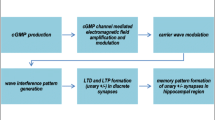Abstract
This paper proposes a novel application of Formal Concept Analysis (FCA) to neural decoding: the semantic relationships between the neural representations of large sets of stimuli are explored using concept lattices. In particular, the effects of neural code sparsity are modelled using the lattices. An exact Bayesian approach is employed to construct the formal context needed by FCA. This method is explained using an example of neurophysiological data from the high-level visual cortical area STSa. Prominent features of the resulting concept lattices are discussed, including indications for hierarchical face representation and a product-of-experts code in real neurons. The robustness of these features is illustrated by studying the effects of scaling the attributes.
Similar content being viewed by others
References
Georgopoulos, A.P., Schwartz, A.B., Kettner, R.E.: Neuronal population coding of movement direction. Science 233(4771), 1416–1419 (1986)
Földiák, P.: The ‘ideal homunculus’: statistical inference from neural population responses. In: Eeckmann, F., Bower, J. (eds.) Computation and Neural Systems, pp. 55–60. Kluwer, Norwell (1993)
Oram, M.W., Földiák, P., Perrett, D.I., Sengpiel, F.: The ‘ideal homunculus’: decoding neural population signals. Trends Neurosci. 21, 259–265 (1998)
Quiroga, R.Q., Reddy, L., Koch, C., Fried, I.: Decoding visual inputs from multiple neurons in the human temporal lobe. J. Neurophysiol. 98(4), 1997–2007 (2007)
Duda, O.R., Hart, P.E., Stork, D.G.: Pattern Classification. Wiley, New York (2001)
Cover, T.M., Thomas, J.A.: Elements of Information Theory. Wiley, New York (1991)
Földiák, P.: Sparse neural representation for semantic indexing. In: XIII Conference of the European Society of Cognitive Psychology (ESCOP-2003). http://www.st-andrews.ac.uk/~pf2/escopill2.pdf (2003)
Wille, R.: Restructuring lattice theory: an approach based on hierarchies of concepts. In: Rival, I. (ed.) Ordered Sets, pp. 445–470. Reidel, Dordrecht-Boston (1982)
Ganter, B., Wille, R.: Formal Concept Analysis: Mathematical Foundations. Springer (1999)
Ganter, B., Stumme, G., Wille, R. (eds.): Formal concept analysis, foundations and applications. In: Lecture Notes in Computer Science, vol. 3626. Springer (2005)
Priss, U.: Formal concept analysis in information science. Annu. Rev. Inf. Sci. Technol. 40, 521–543 (2006)
Földiák, P., Endres, D.: Sparse coding. Scholarpedia 3(1), 2984. http://www.scholarpedia.org/article/Sparse_coding (2008)
Földiák, P.: Forming sparse representations by local anti-Hebbian learning. Biol. Cybern. 64, 165–170 (1990)
Földiák, P.: Sparse coding in the primate cortex. In: Arbib, M.A. (ed.) The Handbook of Brain Theory and Neural Networks, 2nd edn., pp. 1064–1068. MIT Press (2002)
Olshausen, B.A., Field, D.J., Pelah, A.: Sparse coding with an overcomplete basis set: a strategy employed by V1. Vis. Res. 37(23), 3311–3325 (1997)
Olshausen, B.A.: Learning linear, sparse, factorial codes. Technical Report AIM 1580 (1996)
Simoncelli, E.P., Olshausen, B.A.: Natural image statistics and neural representation. Annu. Rev. Neurosci. 24, 1193–1216 (2001)
Rolls, E.T., Treves, A.: The relative advantages of sparse versus distributed encoding for neuronal networks in the brain. Netw. 1, 407–421 (1990)
Dayan, P., Abbott, L.F.: Theoretical Neuroscience. MIT Press, London, Cambridge (2001)
Jones, J.P., Palmer, L.A.: An evaluation of the two-dimensional Gabor filter model of simple receptive fields in cat striate cortex. J. Neurophysiol. 58(6), 1233–1258 (1987)
Ringach, D.L.: Spatial structure and symmetry of simple-cell receptive fields in macaque primary visual cortex. J. Neurophysiol. 88, 455–463 (2002)
Földiák, P., Xiao, D., Keysers, C., Edwards, R., Perrett, D.I.: Rapid serial visual presentation for the determination of neural selectivity in area STSa. Prog. Brain Res. 144, 107–116 (2004)
Oram, M.W., Perrett, D.I.: Time course of neural responses discriminating different views of the face and head. J. Neurophysiol. 68(1), 70–84 (1992)
Endres, D., Földiák, P.: Exact Bayesian bin classification: a fast alternative to bayesian classification and its application to neural response analysis. J. Comput. Neurosci. 24(1), 21–35 (2008). doi:10.1007/s10827-007-0039-5
Endres, D.: Bayesian and information-theoretic tools for neuroscience. Ph.D. thesis, School of Psychology, University of St. Andrews, U.K. http://hdl.handle.net/10023/162 (2006)
Bishop, C.M.: Pattern Recognition and Machine Learning. Springer (2007)
Hinton, G.E.: Products of experts. In: Ninth International Conference on Artificial Neural Networks ICANN 99, number 470 in ICANN (1999)
Kiani, R., Esteky, H., Mirpour, K., Tanaka, K.: Object category structure in response patterns of neuronal population in monkey inferior temporal cortex. J. Neurophysiol. 97(6), 4296–4309 (2007)
Földiák, P.: Neural coding: non-local but explicit and conceptual. Curr. Biol. 19(19), R904–R906 (2009)
Kay, K.N., Naselaris, T., Prenger, R.J., Gallant, J.L.: Identifying natural images from human brain activity. Nature 452, 352–255 (2008). doi:10.1038/nature06713
Miyawaki, Y., Uchida, H., Yamashita, O., Sato, M., Morito, Y., Tanabe, H., Sadato, N., Kamitani, Y.: Visual image reconstruction from human brain activity using a combination of multiscale local image decoders. Neuron 60, 915–929 (2008)
Author information
Authors and Affiliations
Corresponding author
Rights and permissions
About this article
Cite this article
Endres, D.M., Földiák, P. & Priss, U. An application of formal concept analysis to semantic neural decoding. Ann Math Artif Intell 57, 233–248 (2009). https://doi.org/10.1007/s10472-010-9196-8
Published:
Issue Date:
DOI: https://doi.org/10.1007/s10472-010-9196-8
Keywords
- Formal concept analysis
- FCA
- Neural code
- Sparse coding
- High-level vision
- STS
- Bayesian classification
- Semantic
- Neural decoding




